Isn't it fascinating how a few numbers and letters can define your riding experience? When you're faced with motorcycle engine specs, it can feel overwhelming, but understanding them is vital for making informed choices. From engine displacement to torque specifications, each detail plays a significant role in performance. By mastering these ten tips, you'll gain clarity on what truly matters for your ride. So, what are the key elements you should focus on to guarantee your motorcycle meets your needs? Let's break it down further.
Key Takeaways
- Understand engine displacement to gauge acceleration potential and match it to your riding style and intended use.
- Analyze power output and torque specifications, as they significantly affect acceleration and overall performance.
- Familiarize yourself with compression ratios and how they relate to fuel types for optimal engine performance.
- Explore different engine configurations and cylinder arrangements to determine their impact on power delivery and handling.
Understanding Engine Displacement
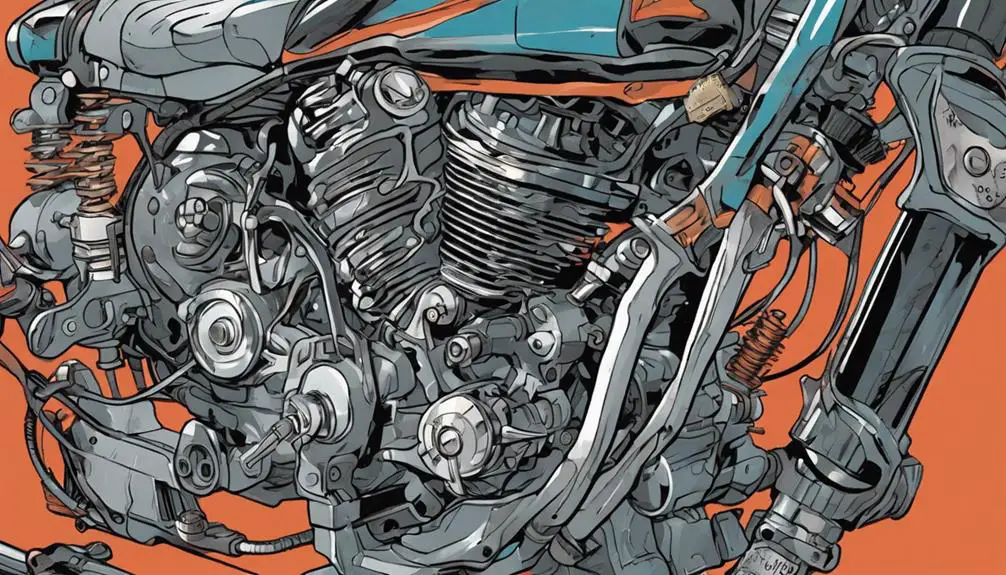
When you explore motorcycle specs, engine displacement is a key factor that can make or break your riding experience. It refers to the total volume of all the cylinders in your engine, typically measured in cubic centimeters (cc) or liters. Bigger doesn't always mean better, but understanding this number is essential for choosing a bike that matches your needs.
Engine displacement directly influences your bike's power and torque, which are important for acceleration and overall performance. If you crave the thrill of quick take-offs and agile handling, a larger displacement might be what you're after. However, smaller engines offer a lighter frame and can provide a more nimble ride, perfect for maneuvering tight corners and urban environments.
Consider how you plan to ride: are you hitting the open road or cruising through city traffic? Your choice in displacement affects not just power, but also fuel efficiency and maintenance costs.
Balancing these factors helps you achieve the freedom you desire on two wheels. Get clear on your riding style, and you'll find the engine displacement that liberates your spirit and enhances your journey.
Embrace the ride!
Analyzing Compression Ratios
When you look at a motorcycle's compression ratio, you're really seeing how efficiently the engine can convert fuel into power.
This ratio greatly impacts your bike's performance and how it responds to different fuel types.
Let's break down what compression ratio means, its effects, and how you can adjust it for peak performance.
Understanding Compression Ratio
Understanding the compression ratio is essential for optimizing your motorcycle's engine performance and efficiency.
The compression ratio represents the difference between the volume of the combustion chamber when the piston is at the bottom of its stroke and when it's at the top. In simpler terms, it's the measure of how much the air-fuel mixture gets compressed before ignition.
When you know your motorcycle's compression ratio, you can better appreciate how it affects power and fuel efficiency. A higher compression ratio often means more power, but it can also demand higher octane fuel to prevent knocking. You'll want to find the right balance that suits your riding style.
To calculate the compression ratio, you can use a simple formula: divide the total cylinder volume by the combustion chamber volume. This number helps you make informed choices about modifications, tuning, or even which fuel to use.
Impact on Performance
The compression ratio directly influences your motorcycle's performance, affecting everything from horsepower to fuel efficiency. A higher compression ratio typically means more power. This translates to a snappier throttle response and a more exhilarating riding experience. When you twist the grip, you want that surge of energy, and a well-tuned compression ratio delivers just that.
However, it's not just about raw power. Fuel efficiency plays a significant role in your journey toward freedom. A balanced compression ratio allows your engine to extract maximum energy from each drop of fuel, letting you ride longer without frequent stops. You want to feel the wind in your hair, not the anxiety of running low on gas.
Keep in mind that an excessively high compression ratio can lead to knocking, which robs your engine of efficiency and performance. It's a balancing act—aim for that sweet spot where your bike feels alive without compromising reliability.
Ultimately, understanding how compression ratios impact your ride empowers you. It gives you the knowledge to choose a motorcycle that truly aligns with your desire for adventure and liberation on the open road. So, embrace this knowledge and feel the freedom you deserve.
Adjusting for Fuel Types
Adjusting your motorcycle's compression ratio can optimize its performance based on the type of fuel you use, allowing for a smoother and more efficient ride.
When you choose high-octane fuel, you can run a higher compression ratio, which means more power and better efficiency. This is because higher compression allows your engine to extract more energy from each drop of fuel.
However, if you're using regular fuel, it's vital to adjust your compression ratio downwards. Running a high compression ratio on low-octane fuel can lead to knocking, which can damage your engine over time. So, understanding the octane rating of your fuel is essential.
You don't have to be an expert mechanic to make these adjustments. Start with a compression gauge to measure your current ratio. If you find your ratio's too high for the fuel you're using, consider changing the pistons or head gaskets to fine-tune it.
Deciphering Power Output
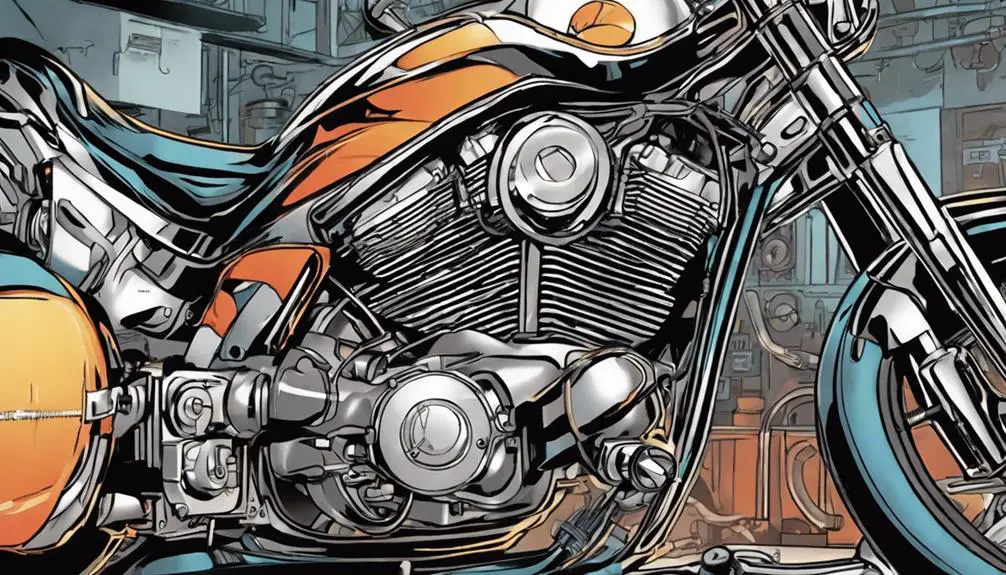
When evaluating a motorcycle's performance, power output plays a crucial role in determining how well it accelerates and handles on the road. You'll often see power measured in horsepower (hp) or kilowatts (kW), and it's important to understand what these numbers mean for your riding experience. A higher power output typically translates to quicker acceleration and a more thrilling ride, giving you the freedom to conquer the open road with ease.
However, it's not just about the peak power; you should also consider the power curve. A smooth, broad power curve allows for better control and responsiveness, letting you tap into that raw power whenever you need it. You want a bike that feels alive beneath you, ready to unlock its potential without hesitation.
Keep an eye on the RPM range where the engine delivers its peak power. If it's too high, you may find yourself constantly shifting gears, which can be tiring and disrupt your flow. Aim for a balance that matches your riding style and the type of freedom you seek.
Ultimately, understanding power output enables you to choose a motorcycle that aligns with your desire for liberation on two wheels.
Interpreting Torque Specifications
Understanding torque specifications is just as important as grasping power output, as torque influences how quickly your motorcycle can accelerate and how it handles in various riding conditions.
Torque is the force that propels your bike forward, affecting your ride's responsiveness and performance. When you check the torque figures, pay attention to the range, which indicates where the engine delivers its best performance.
Higher torque at lower RPMs means you'll feel that satisfying push as soon as you twist the throttle, perfect for quick getaways and maneuvering through city streets. Conversely, if the torque peaks at higher RPMs, you'll find your sweet spot in more open, high-speed scenarios.
Also, consider how torque interacts with your bike's weight and gearing. A lighter bike with strong low-end torque can feel more agile, while a heavier bike might require more horsepower to achieve similar thrills.
Exploring Engine Configuration
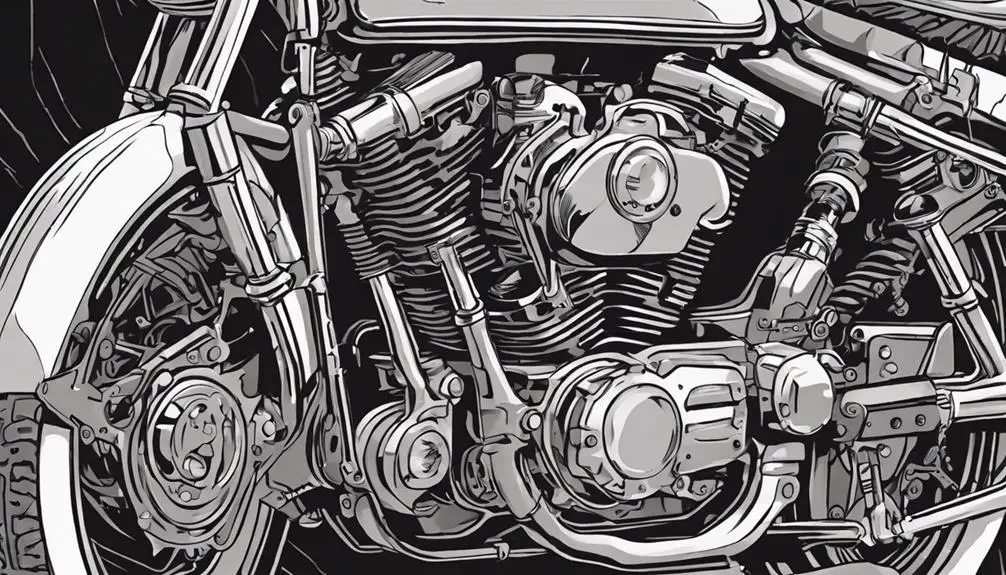
When you think about engine configuration, it's essential to understand the various engine types and how they affect performance.
The arrangement of cylinders plays a significant role in the bike's handling and power delivery.
Knowing these details can help you make a more informed choice when selecting your motorcycle.
Engine Types Overview
Motorcycle engines come in various configurations, each offering unique characteristics that influence performance and handling. These configurations can define your riding experience, so it's essential to know what suits your desires.
You'll often encounter single-cylinder, parallel-twin, V-twin, inline-four, and even more exotic options like flat or rotary engines. Each type has its flair. For instance, single-cylinder engines are lightweight and nimble, perfect for those who crave agility in urban settings. V-twins deliver a powerful, throaty growl, offering a robust torque curve that many riders love.
Inline-fours, on the other hand, provide smooth power delivery and high revs, ideal for those who seek speed on open highways. It's all about what you want.
When you're looking for freedom on two wheels, the engine configuration you choose will impact how you connect with the road. Dive deep into each type and consider how they align with your riding style.
Whether you're cruising through the city or tearing up twisty backroads, understanding these engine types will help you release your true riding potential. Your journey begins with the right choice!
Cylinder Arrangement Importance
How does the arrangement of cylinders impact your riding experience and the overall performance of a motorcycle? It's all about how power and balance mesh together. Different configurations—like parallel twins, V-twins, and inline fours—each come with distinct advantages.
For instance, a V-twin often delivers that raw torque you crave for thrilling acceleration, while an inline four typically offers higher revs and smoothness for those long, open stretches.
But it's not just about power. The arrangement also affects weight distribution and handling. A lower center of gravity from a flat engine can enhance stability, making your ride feel more grounded. Conversely, a higher center of gravity might make you feel a bit more nimble, perfect for agile cornering.
Understanding these nuances helps you choose a bike that truly speaks to your spirit of freedom. Whether you want that gut-punching torque or a rev-happy engine, the cylinder arrangement plays an essential role in shaping your riding experience.
Recognizing Fuel Types
Understanding the type of fuel your bike requires is essential for ideal performance and engine longevity. Different motorcycles are designed to run on specific fuel types, and using the wrong one can lead to poor performance or even engine damage. You'll typically find your fuel requirements listed in the owner's manual or on a label near the fuel tank.
Most motorcycles run on either regular unleaded gasoline or premium. If your bike calls for premium, don't skimp; that higher octane is often necessary for peak engine operation. High-performance engines, especially in sport bikes, benefit from the increased resistance to knocking that premium fuel provides.
You might also encounter motorcycles that run on alternative fuels, like ethanol blends or even electric models. If you're feeling adventurous, consider exploring these options, as they can offer a unique riding experience while also being kinder to the environment.
Ultimately, recognizing your motorcycle's fuel needs empowers you to make informed choices, allowing you to release the full potential of your ride. Always fuel up wisely, and you'll enjoy the freedom of the open road without worrying about your machine's well-being.
Evaluating Cooling Systems
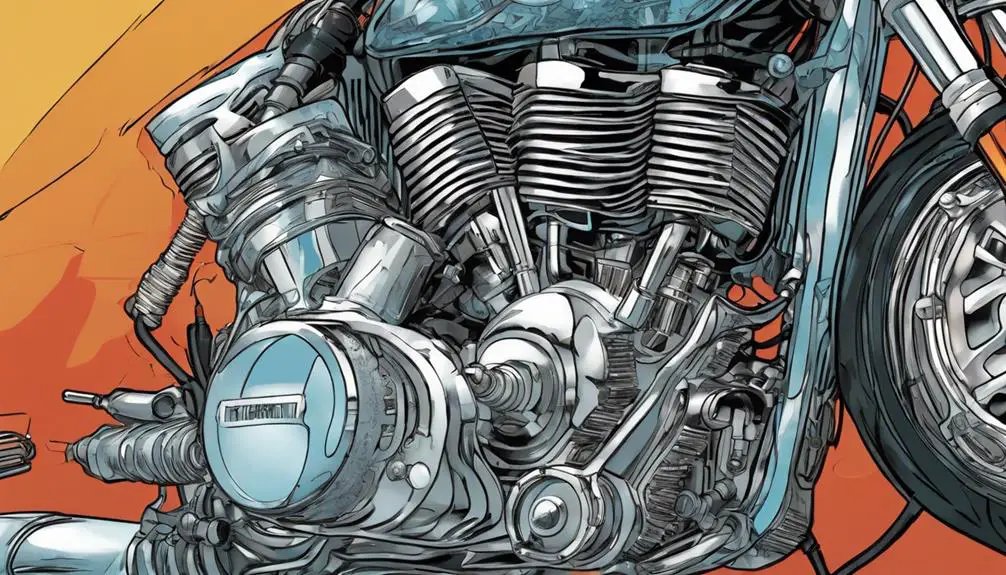
Evaluating your bike's cooling system is essential for maintaining ideal engine performance and preventing overheating during rides. A well-functioning cooling system not only extends your engine's life but also enhances your riding experience.
Here are four key aspects to take into account:
- Type of Cooling: Determine if your bike uses air-cooled or liquid-cooled systems. Each has its pros and cons, so know what suits your riding style.
- Coolant Levels: Regularly check your coolant levels. Low coolant can lead to overheating, compromising your ride.
- Radiator Condition: Inspect the radiator for leaks or blockages. A clean radiator ensures maximum heat dissipation, keeping your engine cool.
- Thermostat Functionality: Make certain the thermostat opens and closes as it should. A malfunctioning thermostat can cause erratic temperature fluctuations.
Identifying Valve Timing
When it comes to your motorcycle's performance, understanding valve timing is essential.
You need to know the basics, the importance of timing specs, and how adjusting them can boost your ride.
Let's break down these key elements to help you maximize your engine's potential.
Understanding Valve Timing Basics
Valve timing plays an essential role in engine performance, as it determines the precise moments when the intake and exhaust valves open and close during the combustion cycle. By understanding valve timing basics, you can reveal the potential of your motorcycle's engine, enhancing its responsiveness and efficiency.
Here are four key aspects to identify valve timing:
- Valve Overlap: This is the period when both the intake and exhaust valves are open. It can affect engine breathing and performance, especially at high RPMs.
- Timing Marks: Most engines have specific timing marks on the camshaft and crankshaft. Knowing how to align these marks is vital for proper timing setup.
- Lift and Duration: These factors determine how far and how long the valves stay open, impacting power delivery throughout the RPM range.
- Cam Profiles: Different camshaft designs can greatly alter valve timing, affecting torque and horsepower characteristics.
Importance of Timing Specs
Understanding timing specs is essential for improving your motorcycle's performance and ensuring that the engine runs smoothly and efficiently.
Valve timing plays a vital role in how your engine breathes, affecting power delivery and overall responsiveness. When you get familiar with these specs, you're taking a step toward liberation on the road, releasing your bike's true potential.
Timing specs define when the intake and exhaust valves open and close in relation to the piston's position. If you know these numbers, you can better understand how your engine operates at different RPMs. A precise valve timing setup means your engine can achieve maximum combustion, leading to more power and better fuel efficiency.
You'll also notice how timing impacts throttle response; the right specs allow for a snappy acceleration that gives you that exhilarating feel of freedom as you ride.
Adjusting for Performance Gains
Adjusting your motorcycle's valve timing can release significant performance gains, enhancing throttle response and overall power delivery. By fine-tuning this vital aspect, you can unlock your bike's potential and experience a ride that feels truly exhilarating. Here's how to get started:
- Understand Your Engine's Specs: Familiarize yourself with the factory settings and what they mean for your performance goals.
- Invest in Quality Tools: A timing light and adjustable cam gears can help you make precise adjustments.
- Experiment with Timing: Alter the intake and exhaust timing to optimize power delivery across different RPM ranges.
- Test and Tune: After adjustments, take your motorcycle for a spin. Note any changes in acceleration, throttle response, and overall feel.
These steps will help you release the true power of your ride.
Remember, achieving the perfect valve timing isn't just about numbers; it's about feeling the freedom and thrill that comes with every twist of the throttle.
Embrace the journey, and don't hesitate to tweak until you find that sweet spot!
Assessing Weight and Dimensions
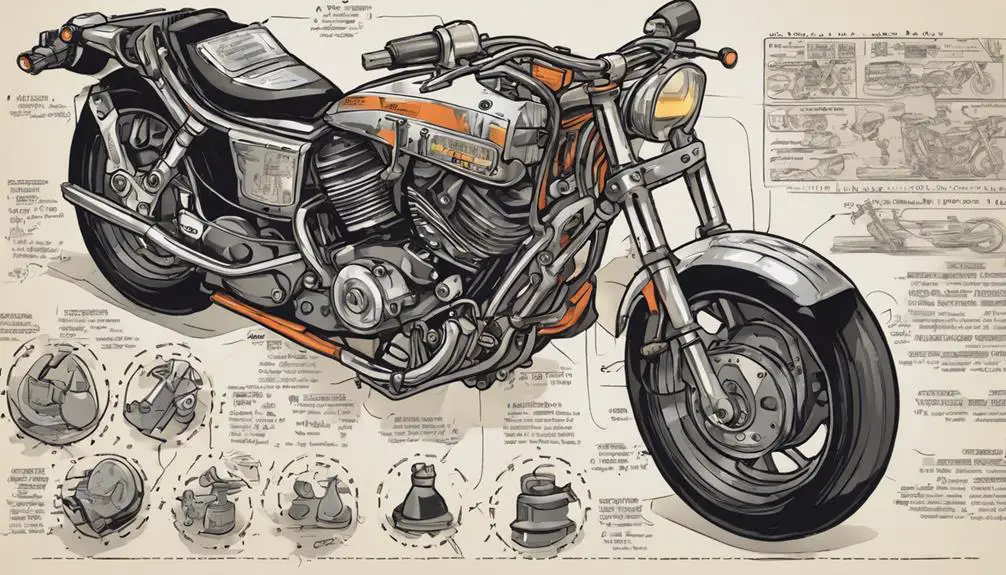
When evaluating motorcycle specs, weight and dimensions play a crucial role in determining performance and handling. The bike's weight directly affects how agile and responsive it feels on the road. A lighter motorcycle can provide a sense of liberation, allowing you to navigate through traffic or twisty roads with ease. On the other hand, a heavier bike may offer more stability at high speeds but could feel cumbersome in tight spots.
Next, consider the dimensions, like seat height and wheelbase. A lower seat height can make it easier for you to plant your feet firmly on the ground, giving you confidence when stopping. Meanwhile, a longer wheelbase often contributes to smoother rides but can limit maneuverability.
Also, think about how these specs align with your riding style. If you crave freedom and spontaneity, look for a bike that feels nimble and easy to handle.
Ultimately, understanding the weight and dimensions of a motorcycle empowers you to choose a bike that matches your desire for adventure and liberation on the open road. Trust your instincts, and let the specs guide you to your perfect ride.
Checking Maintenance Schedules
Keeping up with maintenance schedules is essential for guaranteeing your motorcycle runs smoothly and reliably. You don't want to be stuck on the side of the road because you neglected a simple task.
Here's a quick checklist to help you stay on top of your bike's maintenance:
- Oil Changes: Regularly check and change your oil based on your owner's manual. Clean oil keeps your engine running efficiently.
- Tire Pressure and Tread: Inspect your tire pressure and tread depth every month. Properly inflated tires improve handling and safety.
- Brake Inspection: Don't overlook your brakes! Check pads and fluid levels to guarantee you can stop on a dime when you need to.
- Chain Maintenance: Keep your chain clean and lubricated. A well-maintained chain extends its life and enhances your ride's performance.
Frequently Asked Questions
How Do Engine Specs Affect Motorcycle Insurance Rates?
Engine specs can greatly affect your motorcycle insurance rates.
Higher horsepower and larger engine sizes often lead to increased premiums, as insurers view them as riskier. If you've got a powerful machine, you might pay more.
Conversely, a smaller engine might help you save on insurance costs.
It's crucial to weigh your choices carefully, as the thrill of a powerful bike can come with a higher financial responsibility regarding insurance.
What Are the Environmental Impacts of Different Engine Types?
When it comes to engine types, the environmental impacts can feel like a raging storm versus a gentle breeze.
You've got gas engines belching out pollution like dragons, while electric engines whisper clean energy like a revolutionary anthem.
The choice you make can either poison the air or clear the skies.
Can Engine Specs Influence Resale Value?
Yes, engine specs can definitely influence resale value.
When you understand what makes an engine appealing—like horsepower, torque, and fuel efficiency—you can make smarter buying or selling decisions.
A well-regarded engine often commands a higher price, attracting buyers looking for performance or reliability.
How Do Riding Styles Affect Engine Performance?
Your riding style considerably influences engine performance.
If you're zipping through urban streets, you'll rely on quick acceleration and responsive throttle, which can strain the engine. On the other hand, cruising at steady speeds allows the engine to operate efficiently, boosting fuel economy.
Aggressive riding can lead to higher wear and tear, while a smooth, relaxed approach often enhances longevity.
Understanding your style helps you maximize your motorcycle's potential and enjoy the ride.
Are There Legal Regulations for Engine Modifications?
Yes, there are legal regulations for engine modifications that you need to be aware of.
Depending on where you live, laws can vary greatly. Some areas require emissions testing or have restrictions on noise levels.
It's essential you check your local regulations before making changes to your bike.
Embracing your freedom to modify is great, but you've gotta make sure you're not crossing any legal lines that could lead to trouble down the road.
Conclusion
By grasping these ten tips, you can confidently decode motorcycle engine specs and make informed decisions.
Picture engine displacement as the heart of your bike, pumping power and torque to your ride.
Think of horsepower and torque figures as your bike's muscle, working together at specific RPMs.
Understanding compression ratios and engine configurations helps you tailor your choice to your style.
With this knowledge, you're not just riding; you're mastering the machine beneath you.
Happy riding!